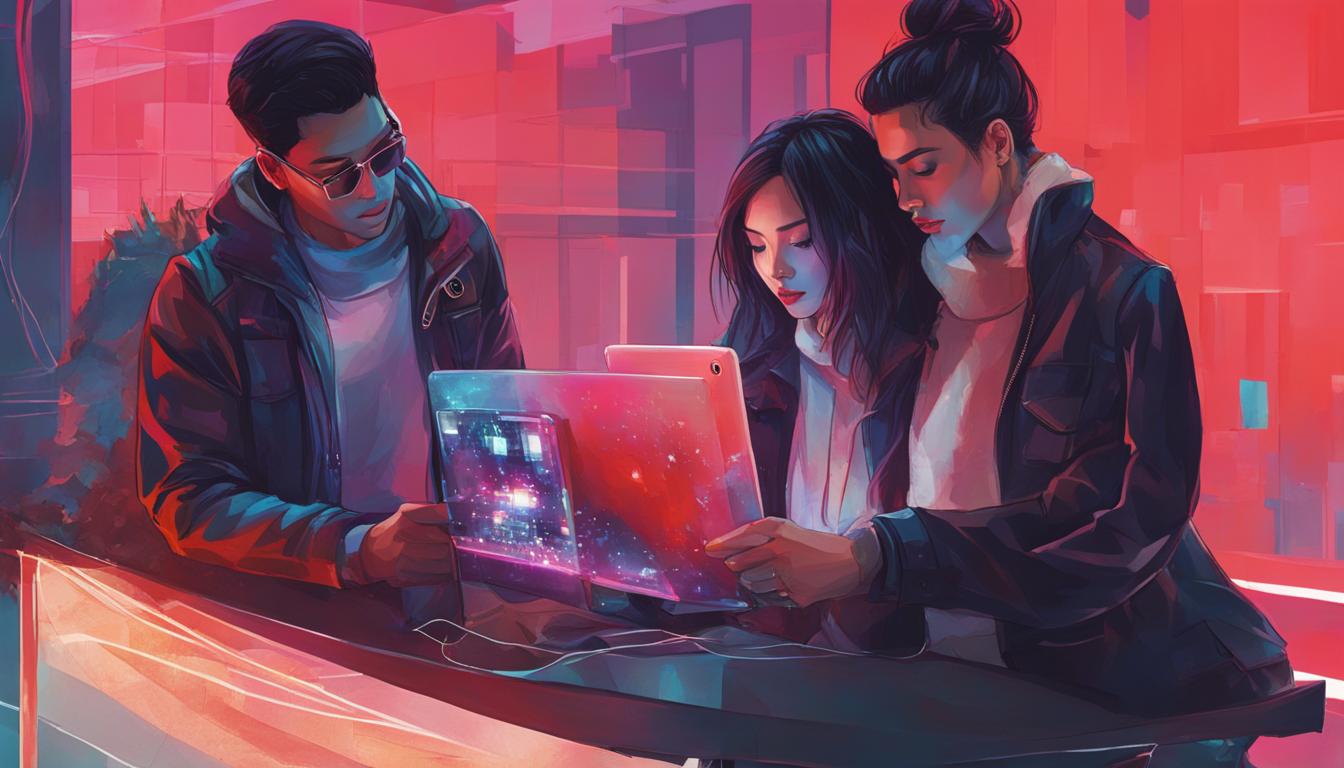In the fast-paced digital era, technology has revolutionized every aspect of our lives, including love and relationships. With the advent of digital tools and platforms, the way we meet, connect, and maintain romantic connections has been profoundly impacted. While some may argue that technology hinders genuine human connection, there are also positive effects that cannot be ignored. In this article, we will explore the role of technology in modern love and how it has shaped romance in the 21st century.
Key Takeaways:
- Technology has transformed the way we form and maintain relationships in the modern era.
- Digital tools and platforms have provided new opportunities to connect with potential partners.
- Algorithms in dating apps help match individuals based on personal information and preferences.
- Data analysis can optimize online dating profiles, increasing the chances of finding a compatible partner.
- While technology has its benefits, it is essential to prioritize genuine human connection and face-to-face interactions.
The Rise of Online Dating and Virtual Connections
The advent of technology has revolutionized the way we approach dating and relationships, giving rise to the popularity of online dating and virtual connections. With the proliferation of online platforms and apps, individuals now have the opportunity to meet potential partners beyond their immediate social circles. This has led to a significant shift in societal norms and a greater emphasis on using technology as a means of finding love.
Online dating has become the second most popular way for people to meet each other, providing a convenient and accessible avenue for individuals of all backgrounds. It allows for quick and easy interaction with others, enabling users to connect with a diverse range of potential partners. However, this increased accessibility also comes with its challenges.
One of the downsides of online dating is the excessive number of options it presents, leading to a phenomenon known as “choice overload.” With so many potential matches at their fingertips, individuals may struggle to make meaningful connections or commit to a single person. This noncommittal behavior, fueled by the seemingly endless options available, has become a common issue in the world of online dating.
The Impact of Technology Dependency
Technology has undoubtedly transformed the way we approach relationships, but it has also given rise to a dependency on digital platforms. In some cases, people rely heavily on technology to facilitate their love lives, prioritizing online interactions over real-life connections. This overreliance on technology can hinder the development of genuine relationships and intimacy.

It is important to strike a balance between virtual and real-life interactions when seeking love through technology. While online platforms offer convenience and broad access to potential partners, it is crucial to remember that true connection often occurs when we step away from the virtual world and engage with others in person.
In the next section, we will explore how dating apps make use of algorithms to match potential partners, highlighting the role of technology in optimizing the search for love.
How Dating Apps Use Algorithms to Match Potential Partners
Online dating has revolutionized the way people meet and connect, and dating apps have become the go-to platform for finding potential partners. But have you ever wondered how these apps match you with your potential soulmate? It all comes down to the power of algorithms.
Dating apps like Tinder, Bumble, Hinge, OkCupid, and Grindr utilize complex algorithms to analyze user data and recommend compatible matches. These algorithms take into account various factors, such as personal information, preferences, and app activity, to increase the chances of finding a suitable partner.
Each dating app has its own unique algorithm. Some apps use an Elo rating system, which assigns a numerical value to each user based on their interactions and attractiveness. Others rely on extensive questionnaires to calculate match percentages, taking into consideration shared interests, values, and goals.
Matching profiles based on algorithms
- The algorithms analyze user profiles and compare them to a vast database of other profiles.
- They look for similarities in interests, values, and lifestyle choices.
- They take into account factors such as location, age, and gender preferences.
- They continuously learn and adapt based on user feedback and success rates.
By using these algorithms, dating apps aim to provide users with more relevant and compatible matches, increasing the chances of finding a meaningful connection. While algorithms can be effective in narrowing down potential matches, it’s important to remember that they are not foolproof. Building a successful relationship still requires open communication, shared values, and genuine connection beyond the initial algorithmic match.

Technology has undoubtedly revolutionized the dating landscape, and algorithms have played a key role in making the process more efficient. However, it’s essential to approach online dating with realistic expectations and an understanding that algorithms are just one piece of the puzzle. Ultimately, the success of a relationship relies on factors that go beyond data and numbers, such as compatibility, chemistry, and emotional connection.
The Power of Data in Finding Love
When it comes to finding true love in the digital age, data can be a powerful tool. By harnessing the information available to us, we can optimize our online dating profiles and increase our chances of finding a compatible partner. Just as businesses use data to understand their customers and improve their products, individuals can use data to understand themselves and improve their chances of finding love.
One example of how data can play a significant role in finding love is the story of Amy Webb. Frustrated with her lack of success in online dating, she decided to take matters into her own hands. Webb created a spreadsheet to track her data and analyze what was and wasn’t working in her dating profile. This data-driven approach allowed her to make informed decisions about how to optimize her profile, leading her to eventually find love.
The use of data in online dating doesn’t end with profile optimization. Dating apps themselves use algorithms to match potential partners based on data analysis. These algorithms take into account personal information, preferences, and app activity to recommend matches that have a higher likelihood of compatibility. Whether it’s calculating match percentages or using an Elo rating system, these algorithms are constantly being refined to improve the chances of finding love.
“Data can play a significant role in finding love. By tracking and analyzing data, individuals can optimize their online dating profiles to increase their chances of finding a compatible partner.”
Embracing technology and utilizing the power of data in our search for love can open up new possibilities and increase our chances of finding a meaningful connection. However, it’s important to remember that while data can provide valuable insights, it shouldn’t be the sole determining factor in our pursuit of love. It’s still essential to cultivate genuine connections, engage in meaningful conversations, and prioritize face-to-face interactions to truly form a deep and lasting relationship.
Love in the Eyes of Technology

Technology’s impact on love has not only been a subject of scientific study but also a topic explored in science fiction. From the portrayal of emotion-seeking androids in “Blade Runner” to the love story between a human and an AI in “Her,” these narratives reflect society’s fascination with the intersection between love and technology. While science fiction often presents a darker perspective, real-life examples suggest that technology has the potential to provide emotional support and create deep connections.
A growing body of research indicates that users can form emotional bonds with voice assistants, such as Siri or Alexa. These intelligent systems, powered by artificial intelligence (AI), offer companionship and understanding to individuals. As AI continues to advance, it may possess the ability to understand and respond to human emotions, further blurring the line between human and machine interaction.
“Technology can provide us with emotional support, and an AI can provide a relationship which might be safer than a human one because there’s less risk of betrayal.”
As technology continues to evolve, there is a wide range of possibilities for how it can shape and enhance our experiences of love and emotional connection. While there are concerns about the potential drawbacks, such as the loss of human connection or the blurring of boundaries between real and artificial relationships, it is important to approach these advancements with an open mind and consider the ways in which they can positively impact our lives.
The New Normal of Dating
In the digital age, online dating has become the new normal, fundamentally changing the way people approach finding love. With the rise of online platforms, individuals are no longer waiting for love to happen by chance. Instead, they actively seek out potential partners through dating apps and websites. This societal shift has extended the age of marriage, with more people choosing to live alone or delay settling down.
Online dating offers a wider pool of potential partners beyond one’s immediate social circle. It provides the opportunity to connect with individuals who share similar interests, values, and goals. The convenience and accessibility of online dating have made it a popular choice for singles of all ages.
However, it’s important to acknowledge that the search for “the one” has evolved. People are now more open to the idea of exploring multiple connections rather than solely focusing on finding a lifelong partner. The emphasis is on meeting different people, gaining new experiences, and discovering what one truly wants in a relationship.

The Benefits of Online Dating:
- Expanded dating pool
- Increased accessibility and convenience
- Opportunity to meet like-minded individuals
- Exploration of personal preferences and desires
The Changing Landscape of Relationships:
“Online dating has shifted our approach to finding love, encouraging us to be more proactive and open-minded in our search. It has allowed us to break free from traditional notions of romance and embrace a broader range of possibilities.”
While online dating has transformed the way we approach relationships, it’s important to remember that genuine connections are still built through human interaction. Face-to-face meetings provide a deeper understanding of someone’s character, emotions, and compatibility. Technology should be seen as a tool to facilitate real-world interactions, rather than a substitute for meaningful human connection.
The Challenges of Technology in Relationship Building
As technology continues to shape the way we form and maintain relationships, it has brought along its own set of challenges. One of the main issues is the rush to judgment based on superficial information. With the abundance of options available in the online dating world, it’s easy to make quick decisions about potential partners without truly getting to know them. This can lead to missed opportunities for genuine connection and meaningful relationships.
Miscommunication is another common challenge in the digital age. Texting and online communication lack the nuances of face-to-face interactions, making it easier for messages to be misinterpreted. Without the ability to see facial expressions or hear tone of voice, it’s easy to misunderstand intentions and emotions. This can lead to unnecessary conflict and can hinder the building of a deep connection.
Additionally, technology can sometimes contribute to a loss of human connection. While digital communication allows us to connect with others across distances, it can also create a sense of isolation when it becomes a substitute for real-life interactions. It’s important to prioritize face-to-face interactions and limit the use of technology as a replacement for genuine human connection.

Navigating Trust and Betrayal in the Digital Age
In the digital age, technology has brought about new challenges in the realm of trust and betrayal within relationships. While technology has undoubtedly enhanced our lives in many ways, it has also introduced opportunities for betrayal and deceit. The ease of online communication and the availability of various platforms have made it easier for individuals to engage in technology-enabled affairs, leading to trust issues and privacy concerns.

Adultery, once solely associated with physical infidelity, has now taken on a new form in the digital landscape. With the advent of social media, dating apps, and messaging platforms, individuals can engage in secretive conversations and form emotional connections outside of their committed relationships. This has created a heightened sense of mistrust and insecurity, as partners may question the fidelity and commitment of their loved ones.
“Trust and privacy become crucial factors in maintaining healthy relationships in the digital age.”
The pervasiveness of technology in our lives also raises concerns about privacy. With the increasing amount of personal information shared online, individuals’ privacy can be compromised, leading to potential risks and vulnerability. The constant connectivity and the temptation of exploring alternative connections have made it challenging for couples to establish and maintain trust in the digital era.
The Importance of Open Communication and Boundaries
In order to navigate the complexities of trust and betrayal in the digital age, open communication and setting clear boundaries are crucial. Couples need to have honest conversations about their expectations, both online and offline, and establish mutually agreed-upon guidelines to ensure trust and transparency. This includes discussing appropriate behavior on social media, limits on interactions with ex-partners or potential love interests, and respecting each other’s privacy.
- Have open and honest conversations about expectations and boundaries.
- Establish guidelines for appropriate behavior on social media.
- Set limits on interactions with ex-partners or potential love interests.
- Respect each other’s privacy and boundaries.
- Regularly check in and communicate about any concerns or insecurities that may arise.
By fostering a culture of open communication, couples can navigate the challenges of trust in the digital age and work towards maintaining a strong and healthy relationship.
The Positive and Negative Impact of Sexting
Sexting, the act of sending explicit messages or images through electronic communication, has become increasingly prevalent in modern relationships. While sexting can have both positive and negative impacts on intimacy, body image, and long-distance relationships, it is important to navigate this practice with open communication and consent.
On the positive side, sexting can add a sense of excitement and intimacy to an ongoing relationship. It allows couples to explore their desires, fantasies, and boundaries in a safe and consensual manner. Additionally, sexting can boost body image by providing a platform for individuals to share and appreciate their physicality.
“Sexting can be a way for couples to maintain a sexual connection and fulfill their desires even when they are physically apart,” says Dr. Jessica Klein, a relationship therapist.
For couples in long-distance relationships, sexting can help bridge the physical gap and maintain sexual satisfaction. It allows partners to feel connected and desired, even when they are unable to be together in person.
However, it is crucial to acknowledge the potential risks and negative impact of sexting. Sending explicit content can lead to privacy concerns, as there is always a risk of the content being shared without consent. It is important to establish boundaries, trust, and open communication with your partner to ensure that both parties feel safe and respected.
“Consent is key when it comes to sexting,” emphasizes Dr. Klein. “Make sure both partners are comfortable and have explicitly given their consent before engaging in any explicit content sharing.”
Sexting should always be a consensual and mutually enjoyable activity within a relationship. It is important to approach sexting with respect, clear communication, and a shared understanding of boundaries to ensure a positive and safe experience.
The Risks and Benefits of Sexting
- Sexting can add excitement and intimacy to a relationship.
- It can boost body image and self-confidence.
- Sexting can help maintain sexual satisfaction in long-distance relationships.
- However, there are potential risks, such as privacy concerns and the spread of explicit content without consent.
- It is crucial to establish boundaries, trust, and open communication when engaging in sexting.

Finding Love Beyond the Screen
While online dating has become increasingly popular, it is important not to discount the value of meeting in person when it comes to finding genuine connections and fostering meaningful relationships. In today’s digital age, where technology often mediates our interactions, meeting face-to-face allows for a deeper understanding of someone’s character and personal chemistry. It provides an opportunity to truly connect on a human level, beyond the constraints of a screen.
Meeting in person allows us to pick up on non-verbal cues, such as body language and tone of voice, which can enhance our understanding of a person’s emotions and intentions. It also provides a more authentic experience, where we can engage in spontaneous conversations and share experiences in real-time. These personal interactions foster a sense of trust and intimacy that cannot be replicated through digital communication alone.
While technology has made it easier to connect with others, it is important to remember that it is merely a tool, and genuine connections are formed through human interaction. By actively seeking opportunities to meet in person, whether through social events, hobbies, or mutual friendships, we can increase the chances of finding love beyond the screen. So, put down your phone, step away from the computer, and open yourself up to the possibility of meaningful connections in the real world.
Adapting to Changes in the Search for Love
As we navigate the future of love, we must acknowledge the cultural shifts that have shaped our approach to relationships. The digital age has brought about significant changes, and finding happiness in relationships requires adaptability and a willingness to embrace new ways of connecting.
Technology has undoubtedly played a role in reshaping the search for love, but it should not overshadow the importance of genuine connections. While online dating has provided convenience and expanded our options, it is crucial to remember that true intimacy is nurtured through face-to-face interactions. As we adapt, we must prioritize finding a balance between digital communication and meaningful human connection.
The Future of Love
Cultural and technological changes continue to influence our pursuit of love. In this ever-evolving landscape, it is essential to remain open-minded and receptive to new possibilities. It may involve embracing emerging technologies, exploring alternative relationship dynamics, or redefining societal norms.
“Love is not static; it evolves with the times. Adapting to these changes allows us to create the kind of relationships that bring us true happiness.”
As we look to the future, it is important to approach love with a sense of curiosity and a willingness to break free from traditional expectations. By adapting to cultural shifts and embracing the opportunities presented by technology, we can navigate the complexities of modern love and find fulfillment in our relationships.
Conclusion
Technology has had a profound impact on relationships in the 21st century. It has revolutionized how we meet, communicate, and maintain connections. While there are both positive and negative aspects to the role of technology in relationships, it is important to navigate these complexities in order to maintain genuine intimacy in a digital age.
The impact of technology on love cannot be ignored. It has provided us with new opportunities for connection, allowing us to meet potential partners beyond our social circles through online platforms and dating apps. However, it has also brought challenges such as excessive options and noncommittal behavior.
In order to maintain intimacy in a digital age, it is crucial to strike a balance between technology and real-world interactions. While technology can facilitate connections, it should not replace the value of face-to-face encounters. By using technology as a tool to enhance, rather than replace, human interaction, we can ensure that our relationships remain grounded in genuine connection and understanding.
In conclusion, technology has transformed the landscape of modern love. It is up to us to embrace its potential and navigate its impact on relationships. By understanding the role of technology, adapting to cultural shifts, and prioritizing genuine connections, we can maintain intimacy and find happiness in our relationships in the midst of the digital age.
FAQ
How has technology impacted relationships in the modern era?
Technology has transformed relationships by changing how we meet, communicate, and maintain connections.
What is the role of online dating in modern relationships?
Online dating has become the second most popular way for people to meet, providing the opportunity to connect with potential partners beyond one’s social circle.
How do dating apps use algorithms to match potential partners?
Dating apps like Tinder, Bumble, Hinge, OkCupid, and Grindr use algorithms that analyze personal information and preferences to recommend compatible matches.
Can data play a significant role in finding love?
Yes, by tracking and analyzing data, individuals can optimize their online dating profiles and increase their chances of finding a compatible partner.
How does technology impact emotional bonds and connections?
Studies have shown that users can form emotional bonds with voice assistants, and as AI advances, technology may have the ability to understand and respond to human emotions.
What is the new norm of dating in the digital age?
Online dating has become the norm, shifting society’s focus away from the traditional idea of finding “the one,” and the average age of marriage has increased.
What are the challenges of technology in relationship building?
Technology can lead to rushed judgments based on surface-level information and miscommunication, potentially leading to a lack of genuine connection.
How does technology impact trust and betrayal in relationships?
While technology has made it easier to engage in extra-marital affairs, trust and privacy become important factors in maintaining healthy relationships in the digital age.
What are the positive and negative impacts of sexting on relationships?
Sexting can add spark and intimacy to a relationship, but it also comes with risks and the potential for misuse, highlighting the importance of open communication and consent.
Should technology replace face-to-face interactions in finding love?
No, meeting in person allows for a deeper understanding and genuine connection, with technology serving as a tool to facilitate real-world interactions.
How should we adapt to technological changes in the search for love?
It is crucial to adapt and find happiness in relationships, embracing the changes brought by technology while maintaining a focus on genuine connections.


